Nabataeans
Q220594Prehistory
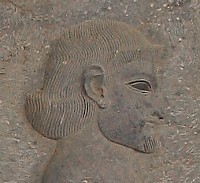
Among the oldest references to Arabs in what is now Jordan is the account of the battle of Qarqar in 853 BCE, in which the Assyrian king Šalmanasser III claims to have conquered a coalition of Syrian rulers. It may have been a defeat, actually, but the operations at Qarqar opened the road to what is now called Syria, Lebanon, Israel, and Jordan. After this, Assyrian texts several times refer to Aribi, which by the time of Tiglath-Pileser III (ruled 745-727) appears to have been a regular payer of tribute. The first reference to Arabs of the Nabataean tribe, which may have lived as nomadic pastoralists near Hegra (modern Mada'in Salih in the northwest of Saudi Arabia), dates to the seventh century BCE. The Biblical book of Genesis mentions a son of Ishmael called Nebajoth, which has been taken as a reference to the Arab tribe,note but although this identification is ancient,note it is by no means certain.
The Assyrians annexed Israel and converted Ammon, Moab, Judah, and Edom into vassal states. Later, when the Babylonians had seized power in the eastern empire, the vassal states became provinces: Judah in 587, Ammon and Moab in 582, while Edom was conquered in 553 by king Nabonidus.note He proceeded further to the south, to the Arab town Tayma and beyond, eventually reaching Yatrib (modern Medina).
It is possible that the story was more complex. From several sources, like the Bible and an ostracon from Arad, we can deduce that after 586, the Edomites infiltrated southern Judah, and it is possible that Nabonidus' action was directed against the Edomites. He may have discovered that the Edomites were, in their turn, under pressure from the Nabataeans. This is speculation, but it may explain why he proceeded to Tayma, and why, in the end, we find the Nabataeans living in what had once been called Edom, and why the Edomites moved to southern Judah.
The next reference to Arabs in southern Palestine and western Jordan comes from the Greek researcher Herodotus, who tells us that the Persian king Cambyses did not subdue the Arabs when he attacked Egypt in 525 BCE, but concluded an alliance, in which the Arab leader promised send supplies to the Persian army.note Herodotus also tells that in his own age, the mid-fifth century, Gaza was an Arab town: interesting evidence for the expansion of the Arabs.
The alliance quickly came to an end, because Cambyses' successor Darius I the Great mentions Arabs as subjects in the Behistun inscription,note which was completed in 521/520. There are no indications that the Arabs were no loyal subjects of later Persian kings. If the Biblical "Nebajoth" does indeed refer to the Nabataeans, Isaiah's remark that they could sacrifice in Jerusalemnote is evidence for the peaceful times.
Rise
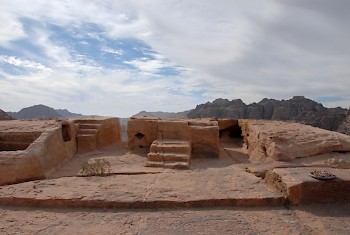
We have now seen how the Arabs came to live in what had always been called Edom. Much of this reconstruction is speculative. We reach more certainty in the late fourth century, after the Macedonian king Alexander the Great had conquered the Achaemenid empire (between 335 and 323). The Nabataeans were now a recognizable political entity with international contacts. This can be deduced from Diodorus,note who tells how king Antigonus I Monophthalmus, one of Alexander's successors, tried to subdue the Nabataeans - in vain. The unsuccessful operations must have had something to do with Antigonus' attempt to invade Egypt, which had been foiled in the battle of Gaza in 312; it seems that the Nabataeans had become an Egyptian ally, and needed to be suppressed if Antigonus wanted to give his invasion plan a second try. Incidentally, it may be noted that one of his officers was Hieronymus of Cardia, a historian, whose description of Nabataean customs has come down to us (here).
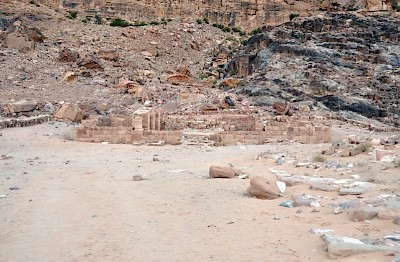
In the next centuries, several authors refer to the Nabataeans, and we can see how they were becoming increasingly sedentary and integrated in the larger world. For example, 1 Maccabeesnote describes how the Jewish leader Jonathan could, in 160 BCE, seek help from a group of allied Nabataeans.note
Gradually, the Nabataeans expanded their territories, especially benefiting from the demise of the Seleucid Empire. Their expansion is, in this aspect, similar to that of the Jewish state of the Hasmonaean dynasty. A difference is that the Nabataeans developed land in the Negev desert, where terraces, cisterns, and dams served to trap water. Similar projects are not known from the
The Nabataean Kingdom
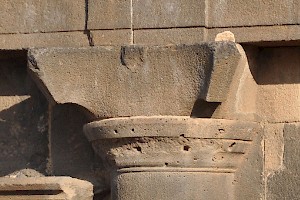
In 63, however, the ways parted. While the Roman commander Pompey the Great annexed the last remains of the Seleucid Empire and subdued the Jews (more...), the Nabataeans remained an independent ally. As a consequence, the process of Hellenization was slower in Arabia Nabataea than in Judaea or the Seleucid towns united in the Decapolis. As Rome's ally, the Nabataean king Obodas III supported the Roman expedition to Yemen in 25, which ended in disaster. Obodas' military adviser Syllaeus was conveniently accused of treason and executed.note
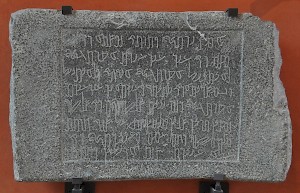
The Nabataean kingdom was quite large. In the north, it controlled Bosra in Syria, and even, though briefly, Damascus. To the south, Hegra (Mada'in Salih) was within the Nabataean frontiers, just like the nearby oasis of Al-Ula, and the port of Leuke Kome. In the east, the Nabataean king controlled several oases (Têma, Hayil, and Dawmat al-Jandal), while in the west, its neighbor was the Jewish kingdom of Herod the Great and his sons, whose realms were later incorporated in the Roman Empire. The capital of the Nabataean kingdom was Petra, but there were many other towns: in the west, Rhinocolura (Al-Arish) and Gaza, in the heartland Bozra and Madaba, while the towns of the Decapolis were at least temporarily or partly under Nabataean control.
| Aretas I | c.169 BCE |
| Erotimus | c.110-c.100 |
| Aretas II | c.110-96 |
| Obodas I | 96-87 |
| Rabbel I | 87 |
| Aretas III the Philhellene | 87-62 |
| Obodas II | 62-60 |
| Malichus I | 60-30 |
| Obodas III | 30-9 BCE |
| Aretas IV Who Loves His People | 9 BCE - 40 CE |
| Malichus II | 40-70/71 |
| Rabbel II the Savior | 71-106 |
According to Strabo, the Nabataean kingdom was well-ruled, and inscriptions (like these ones) tell us about officials with ranks like "governor" and "commander", and prove that laws were well-codified. Dams to control the wadis and trade stations - the Incense Route led through Nabataea - show that the government was capable of organizing great projects.
In some aspects, Nabataean civilization was different from, yes even opposed to Greek and Roman culture. For example, king Aretas IV had as surname "the one who loves his people" - not Philokaisaros or Philoromaios. The Nabataeans designed their own building order and stubbornly stuck to their own alphabet (on which later Arab scripts are based). On the other hand, Graeco-Roman civilization was hard to evade, and the same king Aretas IV was also responsible for building a theater in Petra.
Roman Province
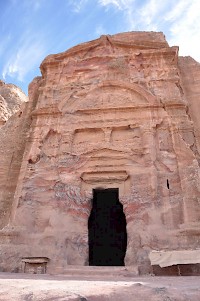
In 106 CE, Nabataea was made a province of the Roman empire by the emperor Trajan, who wanted a better protection of the road from Damascus to Alexandria. The Nabataean troops seem to have offered little resistance, as could be expected, because the kingdom had suffered heavily from the decline of the Incence Route: since Rome had conquered Egypt, trade was increasingly often conducted by sailors, and Nabataean income had diminished.
The Roman period was an age of renewed prosperity. The new masters, who had their seat in Bosra, improved the main north-south road, the ancient Royal Road, which was apparently renamed Via Nova. In the cities of the Decapolis, now part of Nabataea, there were many new buildings. A man named Philip, of Arab descent, became emperor of the Roman world (244-249). Caravan trade with the Parthians in the east usually flourished.
Among the units stationed in Arabia was the Third legion Cyrenaica, which was responsible for the creation of the Limes Arabicus. Later, probably after the Roman emperor Aurelian (270-275) had defeated the Palmyrene Empire, IIII Martia was added, which was based in Betthorus, modern Lejjun. Later, Diocletian (284-305) reorganized the Limes Arabicus. One of the most impressive monuments from this age is Qasr Bshir.
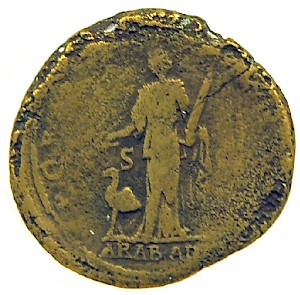
In Late Antiquity, the Limes Arabicus was dismantled. Anastasius I (491-518) recognized a federation of Arab tribal warriors from Yemen, the Ghassanids, as Roman ally, under the condition that they would protect the eastern frontier. They did their job well, occasionally fighting with the Lakhmids, who were fighting for Rome's eastern neighbor, the Sasanian Empire. In 529, the emperor Justinian recognized the Ghassanid leader Harith as king of all Arabs, gave him the rank of patricius, and made him protect all eastern provinces. Slowly, an Arab state came into being: Harith's successor Mundhir (569-581) built residences near Resefa and Damascus in Syria, and near Ain el-Minya in Jordan.
These Arab soldiers were no longer just tribal warriors, but professionals who knew how to fight in a regular army. However, the Byzantine emperors sometimes suspected their ally, because they were Monophysite Christians. In 604, when the Sasanians invaded the Byzantine Empire, the Ghassanids no longer fought for Rome, and it took almost a quarter of a century until the emperor Heraclius had expelled the invaders. When peace was signed in 628, Muhamad was already in charge of Medina, and soon, the Muslims controlled an excellent army, which could easily conquer the war-weary eastern provinces of the Roman Empire, and overthrow the Sasanian Empire.